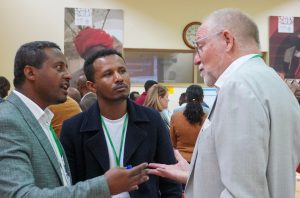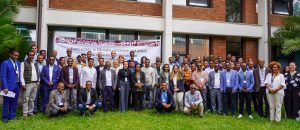Welcome to the first installment of our new blog series highlighting the global impact of our GFSI faculty members. In this edition, we chat with Dr. Arie Havelaar, a distinguished leader in Global Food Safety and Zoonoses recently appointed at the USDA-NACMCF.
One of Dr. Havelaar’s key projects in the Feed the Future Innovation Lab for Livestock Systems portfolio focuses on understanding the dynamics of the diarrhea–causing bacteria, Campylobacter, in Ethiopia. In this interview, Dr. Havelaar talks about the connection between Campylobacter and stunting in young children (Ethiopia has one of the highest rates of stunting in the world at over 30%), and how livestock and cultural customs are involved in this scenario. From studying Campylobacter diversity to looking at how young children come into contact with these bacteria, this interview aims to showcase the impact and some details of this impactful project.

We also want to highlight the importance of a global approach in the improvement of food systems and to tackle some of the most significant challenges we face today. Keep reading to learn more about the fascinating research reshaping our understanding of food safety and nutrition on a global scale.
(These are excerpts from a longer interview with GFSI)
——-
Arie Havelaar: …So, the international work that I do particularly with the Livestock Innovation Lab is one of my main and larger focus areas.
I’m one of the two leaders for human health and nutrition with Sarah McKune, covering the food safety and zoonoses aspects in the lab. Within the Innovation Lab portfolio, I’m leading the CAGED project, which is a project in which I’m looking at Campylobacter in Ethiopia.
Campylobacter has now causally been related to stunting. The digression we’re studying in this project is mainly the whole acquisition patterns of young children of these bacteria. When you talk about Campylobacter in high-income countries, you talk about animal reservoirs, particularly chicken. Here in the US, 60% of all human effects are related to chickens and chicken meat, and there is attribution to milk, and to food products related to livestock.
So when we started in Ethiopia, where we are promoting livestock, we said: well, it can be great for improving animal source food consumption. However, the more and more animals that are in the vicinity of children, the more they will be exposed to the bacteria that are in the livestock, particularly in their droppings.
So we need to understand that better. The Gates Project is really about understanding from birth, till just about one year of age, what is the pattern of acquisition of those bacteria? We do a lot of work on understanding the genomic diversity of those bacteria, trying to figure out where the bacteria that affect children are coming from. Do they come from other humans? Do they come from livestock? There’s a related project in which I’m a co-PI, where we look in detail at the exposure patterns of young children, and how they behave. Particularly what do they put in their mouth? So how do they ingest those bacteria?

GFSI: So, you’re trying to understand how all these kids in Ethiopia are acquiring this Campylobacter bacteria in their system.
AH: Yeah, where do they come from, and how do they get to the children? So there’s, in the end, we can propose methods to try and reduce the exposure.
GFSI: So, because Campylobacter is then related to stunting, in theory, if you can control that infection, you could potentially be reducing stunting in the long term?
AH: Yeah, you would always say that it contributes to study, what we know is a very multifactorial problem. One intervention will never save, or completely address the problem. But if you can nibble a little bit here and nibble off a little bit there, there’s lots to do to get you to make a difference.
GFSI: Yeah, at least you’re improving one dimension of the whole problem, right?
AH: Yeah. So that project is now in its final year, and we’re still doing a lot of analysis, and writing a lot of papers. I’m going to Ethiopia, later this month. There was a large conference in Addis Ababa in September, where we presented the results of the project to the Ethiopian government and other stakeholders. And with the projects that I’m involved in Ethiopia, three projects are ending this year. So there will be a lot of output. By the end of the year, in the sense of submitted papers, and the first half of next year, we expect a lot of output that we can communicate to a larger audience very soon.
——-
Today, we got a small glimpse into Dr. Arie Havelaar’s fascinating research on Campylobacter, stunting, and nutrition in Africa. This interview highlighted some exciting aspects of his work, but there’s much more to discover. In the coming content, we’ll dive deeper not only into Dr. Havelaar’s journey, but we will explore the work of many other GFSI faculty members, exploring more of their research and the important contributions they are making at the global level. Stay tuned for more about GFSI’s impactful work in our upcoming features. We’re just getting started!
 2
2
